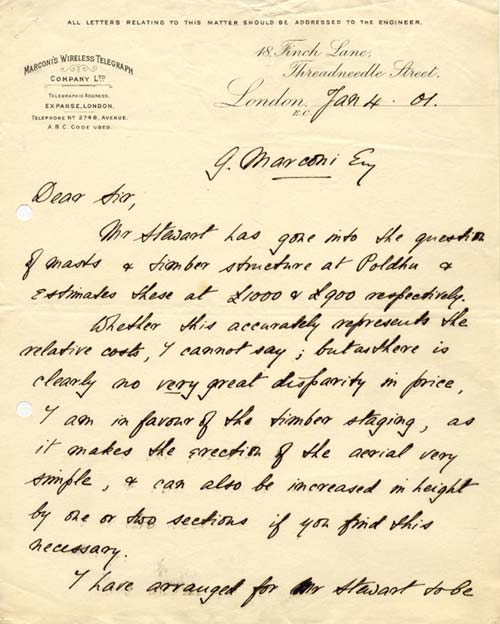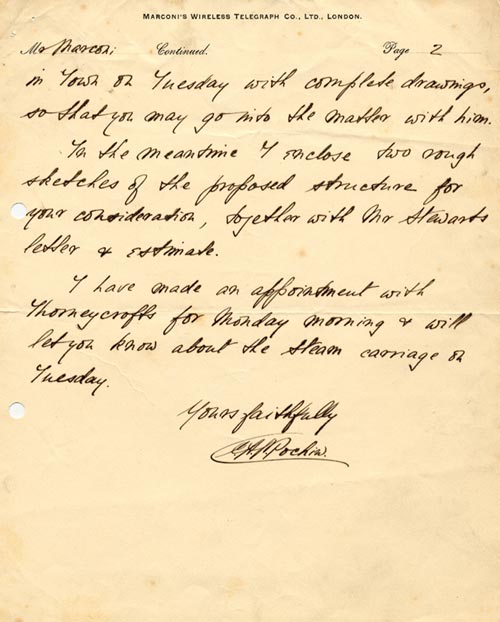 |
|---|
| Documents Marconi |
| Chronologie tlc |
| Chronologie télégraph |
| Chronologie tèléphone |
| Chronologie radio |
| Chronologie TV |
| Chronologie composants |
| IndexScientifiques |
| Bibligraphie |
| Glossaire |
| GUGLIELMO MARCONI
|
| Documents
|
| Lettera a E.A.N. Pochin 4 gennaio 1901 |
| Lettre à E.A.N. Pochin 4 janvier 1901 |
 |
 |
| COSTRUZIONE DI POLDHU |
This
letter to Marconi was sent by EAN Pochin and discusses the construction
of the building and mast at the site at Mullion Cove near Poldhu, where
the new station was being constructed. The letter includes costs for 'the mast and timber structure at Poldhu and estimates these at £1000 & £900 respectively'. Approval for timber as the material for the mast is expressed as it would allow ease of alteration if needed. |
| Poldhu
is best known for the success of the first transatlantic message.
The land on the coast of Cornwall was acquired in 1900 from Viscount Cliften and work started on its construction in October of the same year. Fleming was responsible for designing all the heavy plant apparatus, whilst Marconi devised the aerial circuits. The size of the Poldhu station in comparison with its predecessors was tremendous. One of its key features was the antenna system, which consisted of about 400 wires suspended in an inverted cone from a 200-foot circle of 20, 200 feet high masts. Unfortunately, this system was destroyed in a storm in 1901 and a temporary aerial was constructed using two of the original masts from directly opposite sides of the circle. This was the aerial configuration in place during the transatlantic experiments in December 1901. Eventually the aerial was replaced by four wooden lattice towers, 200 feet high, placed at corners of a square of 200 feet side length, which supported the aerial wires. Arthur Heming, who was an engineer for Marconi, developed the design and the same structures were erected at Cape Cod and other stations. In 1903, the Prince and Princess of Wales visited Poldhu, with the Prince climbing to the top of the one of the towers. During World War I, the station came under Government control. Between the years 1924 to 1932, Poldhu was used by the Marconi Company as a short wave development site under the direction of Franklin and for work on the Imperial Wireless Scheme. The Poldhu station was closed in 1933. In 1937 the site was cleared, 10 acres were donated to the National Trust and a monument erected to mark the significance of the site. The Company gave the remaining 40 acres to the National Trust in 1960. The Poldhu Amateur Radio Club started operating from a hut next to the famous site in 1991. Poldhu looks to be the site of many celebrations throughout the centenary of the first transatlantic wireless transmission in 2001. |
